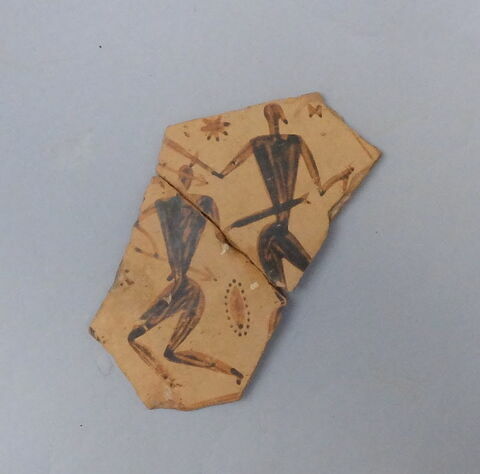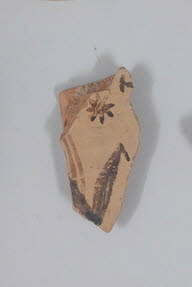Fullscreen Modal
Download
Next
Previous
Download image
cratère
-750 / -725 (3e quart VIIIe s. av. J.-C.)
Place of creation : Athènes Place of discovery : Athènes Dipylon
A 519.1
Département des Antiquités grecques, étrusques et romaines
- Inventory number
- Numéro catalogue : A 519.1
- Artist/maker / School / Artistic centre
-
peintre de A 519
- Object name/Title
- Dénomination : cratère (fragment)
- Description/Features
- Décor : sur rebord ; méandre (hachure, encadré de, losange, pointé, file)
sur vasque (en haut) ; zone (restes, 2, scène figurée) ; registre 1 ; près de l'anse (?) ; motif en roue (2, incluant, croisillon, étoile, 4, entouré de, triangle, file, surmontant) ; mort (2) ; à droite ; scène de combat (plusieurs) ; mort (empilé) ; archer (casque, panache, flèche, attaquant) ; guerrier (épée, attaquant) ; archer (blessé) ; archer (casque, panache, arc, flèche, attaquant) ; guerrier (blessé, renversé, tenant, lance, 2) ; archer (restes, attaquant, guerrier, restes, saisissant) ; hoplite (casque, panache, bouclier, échancré, sur, char, orné de, ligne, brisé, horizontal, tombant, mort) ; dans le champ ; diabolo ; diabolo (pointé) ; svastika ; étoile ; ligne (brisé, horizontal) ; losange (quadrillé) ; tache (entouré de, point)
registre 2 ; à gauche ; scène de combat ; guerrier (?, personnage mythologique masculin, ?, jambe, 4, lance, attaquant) ; guerrier (restes, casque, panache, épée) ; dans le champ ; losange (file, vertical) ; à droite ; hoplite (file, casque, panache, épée, tenant, bouclier, échancré, lance, 2) ; dans le champ ; oiseau (plusieurs)
Etat de l'oeuvre : Il ne reste qu'une partie de la vasque avec le rebord. Composé de plusieurs fragments jointifs recollés entre eux. Peinture en partie effacée. - Dimensions
- Longueur : 38,5 cm
- Materials and techniques
-
Matériau : argile
Technique : peinture, dessin en silhouette
Précision technique : peinture brun rouge (intérieur) ; peinture brun noir (extérieur) ; oeil réservé (hoplite tombé du char) - Date
- Epoque / période : géométrique récent I B
Date de création/fabrication : 3e quart VIIIe s. av. J.-C. (debut) (-750 - -725) - Place of origin
- Athènes
- Place of discovery
- Athènes Dipylon
- Collector / Previous owner / Commissioner / Archaeologist / Dedicatee
-
M. Rayet, Olivier
- Acquisition details
- achat
- Acquisition date
- date : 1884
- Owned by
- Etat
- Held by
- Musée du Louvre, Département des Antiquités grecques, étrusques et romaines
- Current location
-
non exposé
- Mode d'acquisition
- achat
- Materials
- argile
- Techniques
- dessin en silhouette - peinture
- Description/Features
- oiseau - zone - croisillon - diabolo - étoile - file - ligne - losange - méandre - motif en roue - point - svastika - tache - triangle - char - arc - épée - flèche - lance - bouclier - casque - panache - jambe - guerrier - archer - hoplite - personnage mythologique masculin - scène figurée - scène de combat - attaquant - encadré de - entouré de - incluant - orné de - renversé - saisissant - surmontant - tenant - tombant - blessé - mort - sur - à droite - à gauche - dans le champ - en haut - près de l'anse - registre 1 - registre 2 - sur rebord - sur vasque - 2 - 4 - brisé - échancré - empilé - hachure - horizontal - plusieurs - pointé - quadrillé - restes - vertical
- Period
- géométrique récent I B
- Places
- Athènes - Athènes Dipylon
-
Haug, Annette, « Images and History : a discursive approach », dans Images at the crossroads : Media and Meaning in Greek Art, Edingurgh, Edinburgh University Press, 2022, p. 53, fig. 2.6
-
Oulié, Elena, « L’aspective et la question des points de vue sur les vases grecs du viiie siècle av. J.-C. au premier quart du vie siècle av. J.-C. », Pallas, 120, 2022, 87-104, Disponible sur : https://doi.org/10.4000/pallas.25670 , p. 89, 90, 103, fig. 1
-
Coulié, Anne, « François Villard et les vases du Dipylon », dans Céramique et peinture grecques dans la Méditerranée antique : du terrain au musée : hommages à François Villard : [journée du 19 janvier 2016 à l'École du Louvre], Paris, 2019, p. 149
-
Bohen, Barbara, Kratos & krater : reconstructing an Athenian protohistory, Oxford (GB), Archaeopress Archaeology, 2017, p. 93
-
Coulié, Anne, « L'atelier du Dipylon : style, typologie et chronologie relative », dans Vlachou, Vicky (dir.), Pots, workshops and early Iron age society : function and role of ceramics in early Greece : proceedings of the international symposium held at the Université libre de Bruxelles, 14-16 novembre 2013 / co- organised with the University of Athens, Bruxelles, CReA-Patrimoine, 2015, p. 41 à 43, 46, fig. 6
-
Mertens, Joan R., « Chariots in Black-figure Attic Vase-painting: Antecedents and Ramifications », dans Oakley, John (dir.), Athenian Potters and Painters III. The Conference Proceedings. Actes du colloque international tenu au College of William and Mary in Williamsburg, Virginia, 11-14/09/2012 organisé par American School of Classical Studies, Oxford, Oxbow Books, 2014, p. 138, fig. 5, pl. 17A
-
Pollitt, Jerome Jordan (dir.), The Cambridge history of painting in the classical world, New York, Cambridge University Press, 2014, p. 88, fig,, n° 2.20
-
Coulié, Anne, La céramique grecque aux époques géométrique et orientalisante (XIe-VIe siècle av. J.-C.), Paris, Éditions Picard, 2013, p. 76, 77, fig. 47
-
Hurwit, Jeffrey M., « The Shipwreck of Odysseus: Strong and Weak Imagery in Late Geometric Art », American Journal of Archaeology, 115.1, 2011, p. 1-18, Disponible sur : https://www.jstor.org/stable/10.3764/aja.115.1.0001 , p. 6, 15, fig. 14
-
Dietrich, Nikolaus, Figur ohne Raum ? : Bäume und Felsen in der attischen Vasenmalerei des 6. und 5. Jahrhunderts v. Chr., Berlin, de Gruyter, 2010, p. 111, 112, fig. 86
-
Junker, Klaus, « Zur Bedeutung der Frühesten Mythenbilder », dans Zanker, Paul ; Schmidt, Stefan ; Oakley, John (dir.), Hermeneutik der Bilder. Beiträge zur Ikonographie und Interpretation griechischer Vasenmalerei, Beihefte zum Corpus Vasorum Antiquorum, tome IV, Münich, 2009, p. 69, 70, fig. 7
-
Croissant, Francis, Tripodes, 7, 2008, p. 39, fig. 16
-
Zeit der Helden, cat. exp. (Karlsruhe (2008)), 2008, p. 95, 96, n° 20
-
Boardman, John, Early Greek vase painting : 11th-6th centuries BC : a handbook, New York, Thames and Hudson, 1998, p. 26, pl. 50
-
Ahlberg-Cornell, Gudrun, Myth and epos in early Greek art : representation and interpretation, Berlin, Mann, 1992, p. 32, 40, fig. 35, fig. 2, n° 2
-
Rasmussen, Tom ; Spivey, Nigel Jonathan (dir.), Looking at Greek vases, Cambridge, Cambridge University press, 1991, p. 50, n° 17
-
Grunwald, Christiane, « Frühe Kampfdarstellungen », Acta praehistorica et archaeologica, 13/14, 1982, p. 160, fig. 4, n° 1
-
Hampe, Roland, « Aktorione », dans Lexicon Iconographicum Mythologiae Classicae, I, Zürich ; Düsseldorf, Artémis, 1981, p. 474, n° 11
-
Ahlberg-Cornell, Gudrun, Prothesis and ekphora in greek geometric art, Paul Åströms Förlag, Göteborg, 1971, p. 210
-
Ahlberg-Cornell, Gudrun, Fighting on Land and See in Greek Geometric Art, 4, XVI, Stockholm, 1971, p. 12,15 à 17,40,55, fig., n° 6,7,8
-
Coldstream, John Nicolas, Greek geometric pottery. A survey of ten local styles and their chronology., New York, Methuen, 1968, p. 31, n° 17
-
Davidson, Jean M., Attic geometric workshops, Roma, L'Erma di Bretschneider, 1968, p. 28, 134, fig. 11, n° 2A
-
Kunze, Emil, « Bruchstücke attischer Grabkratere », dans Neue Beiträge zur klassischen Altertumswissenschaft, Festschrift zum 60. Geburtstag von Bernhard Schweitzer, (Bruchstücke attischer Grabkratere), 1954, p. 48-58, p. 48 à 58
-
Union académique internationale. (dir.), Villard, François, Corpus Vasorum Antiquorum. France. Fascicule 18, Musée du Louvre. Fascicule 11, [Musée du Louvre, 11], Paris, 1954, pl. 5.7-9, fig. 2
-
Kunze, Emil, « Bruchstücke attischer Grabkratere », dans Neue Beiträge zur klassischen Altertumswissenschaft, Festschrift zum 60. Geburtstag von Bernhard Schweitzer, (Bruchstücke attischer Grabkratere), 1954, p. 48-58, p. 48 à 58
-
Chamoux, François, « L'école de la grande amphore du Dipylon. Étude sur la céramique géométrique à l'époque de l'Iliade. », Revue archéologique, 1945, p. 71, 82
-
Pottier, Edmond, Vases antiques du Louvre. salles A-E, les origines, les styles primitifs, écoles rhodienne et corinthienne, [Musée du Louvre, Paris], Paris, Hachette, 1897, Disponible sur : http://gallica.bnf.fr/ark:/12148/bpt6k62325441/f17.item.zoom , p. 23, pl. 20
-
- Le temps des héros. Les siècles obscurs en Grèce 1200 - 700 avant J.-C., Karlsruhe (Externe, Allemagne), Badisches Landesmuseum, 25/10/2008 - 15/02/2009




